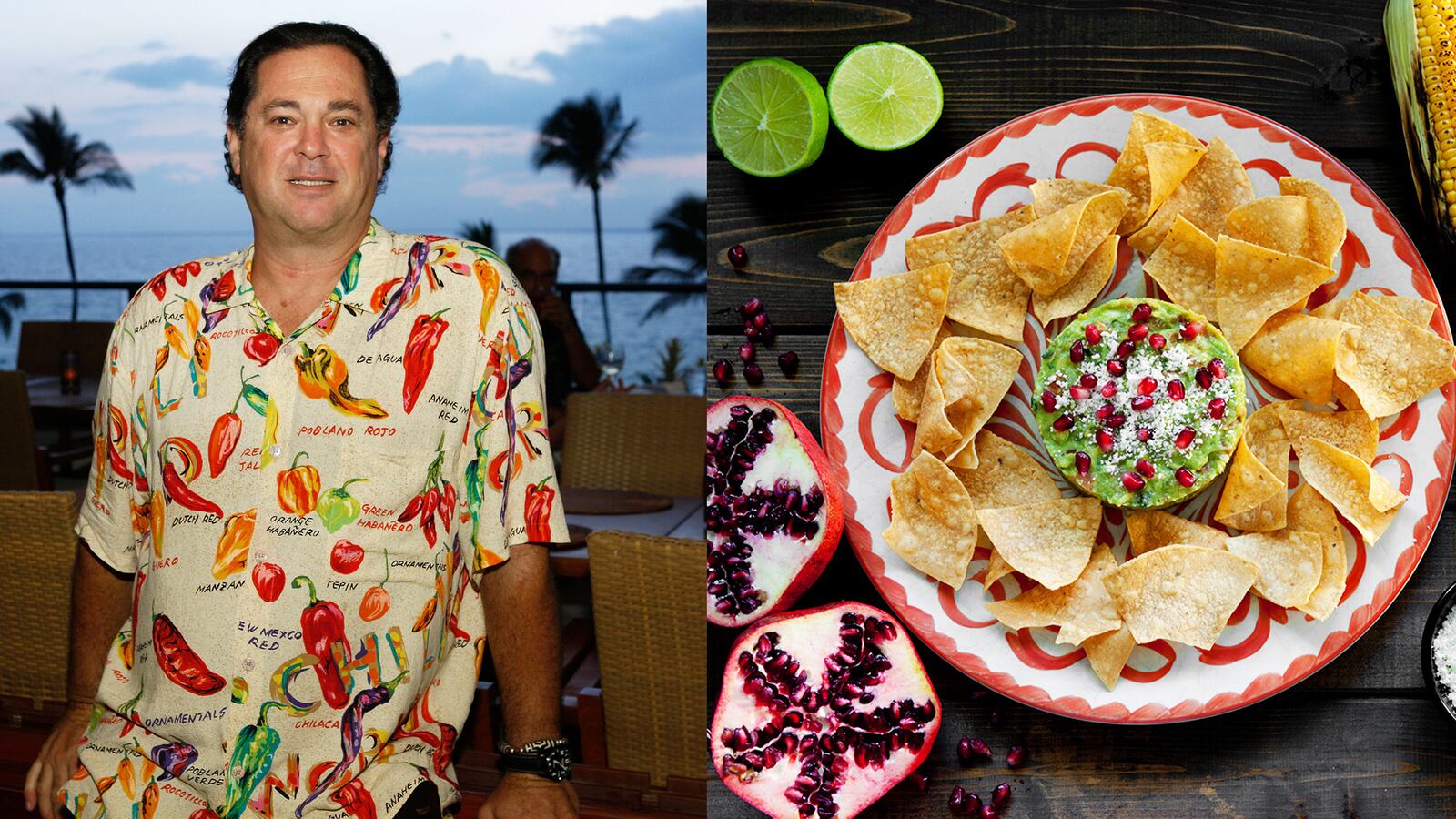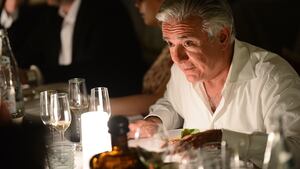Many chefs are lazily called “rock ‘n roll chefs,” but Mark Ellman, now the elder statesmen of Hawaiian cuisine, can truly say he was one of the first.
He began his career in Los Angeles in the ’70s, owning and running a catering company called, refreshingly honestly, Can’t Rock and Roll But Sure Can Cook. His clients were indeed rock stars, from the Beach Boys and the Moody Blues to Olivia Newton-John and a wondrous gamut in between. In 1985, he went to Maui for the first time. His father was his inspiration for the trip.
“My father, who died when I was very young, loved Hawaii, and always vacationed here once a year,” Ellman recently told me. “I was too busy, with girls, and sex and drugs, and I never got to Hawaii until after he died.”
Once he got there, he hooked up with a group of chefs, including legends Roy Yamaguchi and Sam Choy, and together they re-invented Hawaiian cooking, bringing back mostly forgotten traditional recipes and modernizing them. “There was one chef, Peter Merriman, who got us all together for three days on Maui, to eat and drink. We all had the same interests, including committing to the local farmer, local produce.”

“When I opened my first restaurant, Avalon, in the ’80s, it was about 20 percent local ingredients and 80 percent imported from the mainland. Now, it’s a switch, 80 local and 20 from the mainland, just commodity products. There’s great food in Hawaii now. The younger generation are doing some really clever, fresh, innovative things—none of this chemistry stuff, just great, satisfying food.”
Having to bring back Hawaiian cuisine begs the question, where’d it go?
“Hawaii is obviously a tourist destination,” Ellman explains. “In the ’70s and ’80s, all the hotel chefs were either German, Swiss or French, doing all continental cuisine. Fresh fish usually wasn’t on the table. Here, we’re the most isolated island in the world—it takes five hours by plane to get anywhere—but we have the most amazing seafood.” Chefs at the hotels and independent restaurants were catering to tourists. “There was a lot of frozen fish,” he says.
He went on to tell me that flavors in Hawaii are so different from the mainland. “The food and the seafood is fresher here. There’s yellowfin tuna, ahi tuna, mahi-mahi, different kinds of snapper, We buy 75 percent of our fish from the local fishermen, who call me on their way back to land to tell me what they have. I always take all of it!”

Ellman has now lived in Hawaii most of his life. He has started 18 restaurants in the last 35 years, including the Maui Taqueria chain, which he ultimately sold. Currently, he has two extraordinary restaurants that sit side-by-side on the beach in Lahaina on Maui. One is the seafood restaurant, Honu (which means turtle in Hawaiian, and is temporarily closed) and the other is the legendary Frida’s, a beautiful, open-air Mexican restaurant, named, of course, after artist Frida Kahlo. Turtles regularly feed on the water’s edge just yards from the restaurant. Frida’s closed for a while during the pandemic but is open again now.
Here are his five favorite meals
My first two favorites were cooked by the legendary Chef Roger Vergé, who passed away in 2015. I was lucky enough to meet him on a bus trip to Napa Valley with my friends Shep Gordon and Joe Gannon.
The first meal by Chef Vergé was at Shep’s house in Benedict Canyon in Los Angeles. The chef was in town for a dinner event honoring him at Arnold Schwarzenegger’s restaurant Schatzi on Main. We were hanging out and Chef told us to go outside and relax because he was going to make us lunch. About 30 minutes later, he came out of the patio door with two plates in his hands. He served us beautiful lamb chops with a drizzle of peppercorn sauce and sautéed haricots verts. Macerated fresh strawberries and crème fraîche for dessert. For me, the takeaway of that memorable lunch was a giant of the industry who had grown so very tall, but still had the ability to bend.
The second time I had Chef Vergé’s food was at Le Moulin de Mougins, his Michelin three-star restaurant in the South of France. My wife Judy and I were staying with friends in Mougins and, of course, we were there mainly for one reason—to eat at Vergé’s culinary palace. After a tour of the property and the kitchen, we sat down for an extraordinary meal. The amuse-bouche was a first round knockout punch—a two-ounce thimble of the creamiest purée of potatoes topped with a decadent glacé de viande, served with an espresso spoon. To this day, I dream of it. Dinner was a multi-course symphony of St. Pierre, pistou, Breton chicken and Charolais filet mignon. And I am sorry to say, I do not remember what we had for dessert. But I remember clearly we were four very happy people who floated home. This was the first Michelin three-star dinner I had ever experienced. It was so fitting that it was with Chef Vergé!
We traveled to Napoli to experience first-hand—what else?—the pizza. We enjoyed it immensely. However, the surprise was a small, unassuming café behind the boardwalk. The manager, a large man who was also the bartender and the waiter, ordered us some wine that paired well with raw fish. Raw fish? Japan? Yes. Mexico? Yes. Peru? Yes. But Italy? Screaming fresh raw langoustine split down the middle and drizzled with extra-virgin olive oil and Amalfi lemons. Carpaccio of local fresh white fish, black pepper and extra-virgin olive oil. Raw filets of mackerel. Raw clams. Raw oysters! I had no idea.
We drank prosecco and vermentino to our hearts’ delight. We ended up drinking with the manager/ bartender/waiter and closed the place around 1 a.m. We slowly walked back to our hotel. Not under the Tuscan sun, but under the Napoli moon. God, I love Naples!
Growing up in Los Angeles, Mexico was a short three-hour drive. When I was in high school, Tijuana and Baja were our “Disneyland” at least a couple of times a year. Once I got married in my early twenties, we took vacations at a little-known resort called Rancho Agua Caliente, about an hour north of Ensenada. It’s still there, by the way, and is now an ecotourism resort. In 1978, a room was $12 a night. For two broke kids, this was heaven. The rooms were very simple—no phones, no TV, a very thin bed. Ahh, but the swimming pool was filled with hot mineral water and next to the pool were private mineral baths big enough for two people.
The entire property smelled of that rotten egg/sulphur smell. However, once we got there that smell was something we craved and calmed us. Breakfast, lunch and dinner were prepared by Chef Lupe, a lovely older woman with a smile so big and genuine. She made us huevos rancheros every morning with refried beans, eggs from hens on the property and always homemade tortillas. For lunch and dinner, whatever she made was what you were going to eat. We never ever complained or asked for something special. She was the best goddam cook. Chile rellenos, tamales, carne asada, fish mojo de ajo, enchiladas, coctel de camaron, ceviche. I learned so much about Mexican food from Lupe and I miss those days so much. They sold very few items in the bar—Nescafé, sodas, horchata, beer and tequila. The tequila was kept in a very large glass container that held about two gallons and they used a stainless steel ladle to pour the tequila into a glass. And at the bottom of the large glass container was a coiled, four-foot-long rattlesnake, which they claimed made the tequila very smooth to drink. So Chef Lupe left an indelible mark on me of how Mexican food should taste. I always use her simple, delightful food as the benchmark anytime I am eating Mexican food, my favorite food in the world.
Singapore, home of many different ethnicities, is home to an equal number of different cuisines. Halal food, Indian food, Indonesian food and Nyonya (a blend of Chinese and Malaysian foods). Singapore is a tiny nation with a wealth of wonderful flavors and home of the famous Hawker Stalls that have an A+ sanitation rating.
It was almost 20 years ago that we traveled to Singapore for the first time—we always ate at least three or four meals a day when we traveled, to taste as much food as possible! There was one dish that I remember most. One dish that makes me salivate at just the thought of it. The smile of the chef I will never forget. It was one small stall of many and the pot on the stove stopped me in mid-stride. There was a two-foot round pan on an open flame where the chef manipulated a round of fresh dough and flattened it and slapped it into the hot pan that he brushed with ghee right before the slap. And in the pot, a luscious goat curry. Roti Prata—a national dish, a mix of Malaysian and Indian influences. The food to-go was served in these crazy plastic see-through bags. And the roti was rolled on the side. No utensils. You used the roti as the vehicle for the curry. We were in Singapore for five days and I was at the roti stall every day. One day I went twice. The dark amber color of the curry with chunks of tender goat, the magic aroma of ginger and garlic and star anise. Do yourself a favor and go to Singapore and have the chili crab and the nasi goreng. But do not miss roti prata in one of the hawker stalls.
My Five Favorite Meals features the most cherished dining experiences of bartenders, chefs, distillers and celebrities.
Interview has been condensed and edited.








